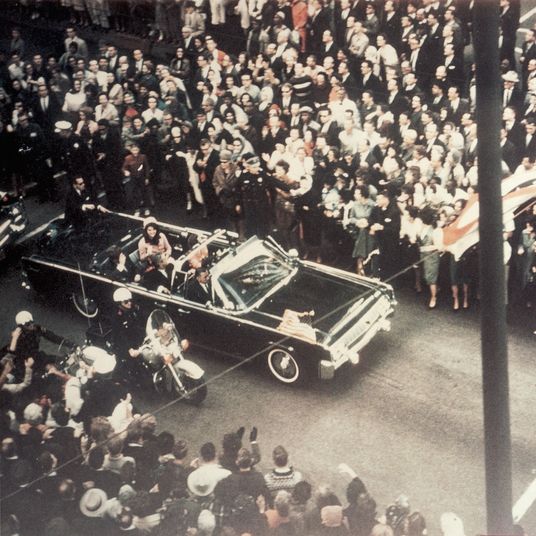
Photo Illustration: Everett Bogue; Photos: Getty Images
Like most people professionally preoccupied with the truly mind-blowing race for the Democratic presidential nomination — and even some folks whose fixation on it is purely recreational — I spent all of last night and much of today combing through the reams of numbers coughed up by 22 separate contests that took place on Super Tuesday. The delegate counts. The superdelegate counts. The exit-poll cross tabs. Oy vey.
By now, if you’re reading this, you already know the basics. That Barack Obama won more states than Hillary Clinton (13-8, with New Mexico still in doubt as of this writing) and looks likely to have won a handful more delegates than she did, though she still retains the advantage because of her lead in superdelegates. The other thing you know is that, because Clinton beat Obama in four of the five biggest states that voted yesterday (California, New York, New Jersey, and Massachusetts), she came away having bested him in the overall popular vote. What you’re probably unaware of, however, is just how slender her margin was: 50.2-49.8 percent, according to some frantic digit-cruncher in the bowels of the Time-Life building. Yes, kids, it really was that close.
That closeness means, by all accounts, a race that now promises — or threatens, if you like — to play out until the Pennsylvania primary on April 22, if not all the way until the Democratic convention this September August. There are countless ways of analyzing how this battle might unfold, but as long as we’re already in green-eyeshade territory, let me offer a few numbers that could well turn out to be particularly important in the days, weeks, and months ahead.
Nine. That’s the number of races on the calendar between now and the end of February. Of them, four are caucuses (Nebraska, Washington, Maine, and Hawaii), four are primaries with a large percentage of African-American voters (Louisiana, Maryland, Virginia, and D.C.), and one is the primary in Wisconsin, a state with a long tradition of pragmatic progressivism and a bent toward retail politics. All of which is to say that there’s a reasonable chance that nine is also the number of races in a row that Clinton will lose before we get to Ohio and Texas, where she is favored. And if that’s the case, the momentum accruing to Obama may prove overwhelming.
69-29. That’s the split between HRC and BHO among Hispanics in California. For the second time running (the first being Nevada), the Obama campaign made a huge push for Latino votes on Super Tuesday. And for the second time running, the candidate simply got crushed. The endorsements of Ted Kennedy and any number of Hispanic leaders seemed to help the hopemonger not a whit. Beyond the long-term worries this inspires about Obama if he wins the nomination, there’s the short-range matter of Texas: the single biggest delegate prize left on the calendar, and one in which Hispanics made up 15 percent of the electorate in 2006, just a little shy of their proportion in California. If Obama can’t improve among Latinos, he can kiss the Lone Star State good-bye.
500ish. That’s the rough number of superdelegates as yet uncommitted to either HRC (who has about 200) or BHO (about 100.) The superdelegates, in case you happen to be wondering, are party big shots: Democratic members of Congress, members of the DNC, Democratic governors, and former party leaders. In a normal year, they don’t matter much; they just pile in behind the party’s consensus choice. But this is not a normal year (duh) and it’s perfectly conceivable, if perfectly appalling, that they may determine the nominee, especially if the race remains undecided by the time of the convention.
$32 million, $13 million, $5 million, and $20 million. The first of these is how much the Obama campaign raised in January — a staggering figure. The second is how much the Clinton campaign raised that month — a relative pittance. The third is the amount, we learned today, that Hillary personally loaned her campaign in the past couple of weeks. And the fourth is the amount that her husband, Bill, is reported to be due as a payout after severing his ties with Ron Burkle — and which, presumably, will soon be available to pay for TV ads in Texas and Ohio.
That the Clintons are now rolling down the path blazed this election cycle by Mitt Romney may raise eyebrows. Is it wise? Maybe, maybe not. But one assumes that they wouldn’t be doing it were it not necessary. And that kind of necessity may add up to a world of trouble. — John Heilemann
Related: John Heilemann explains why Huckabee could be McCain’s solution. [NYM]
Kurt Andersen on why Obama should win. [NYM]
Chris Smith finds signs of the race to come in New York’s primary vote. [NYM]
For a complete guide to presidential candidates Hillary Clinton and Barack Obama — from First Love to Most Embarrassing Gaffe — read the 2008 Electopedia.





























